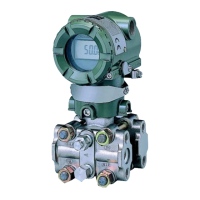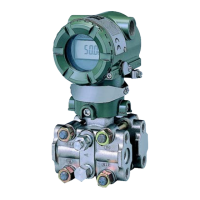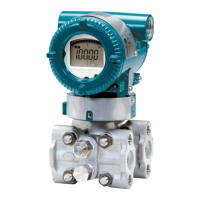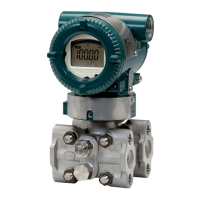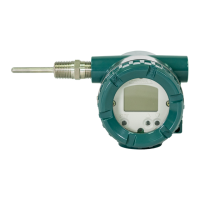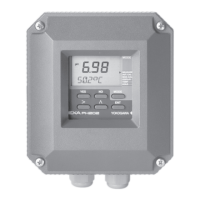IM 01C25T01-01E
3-10
3. OPERATION
3.4.6 Output Signal Low Cut Mode Setup
Low cut mode can be used to stabilize the output
signal near the zero point.
The low cut point can be set in a range from 0 to 20%,
the direct ratio corresponding to the output signal of 4
to 20 mA. (Hysteresis: ±10% of the cut point)
Either LINEAR or ZERO can be selected as the low
cut mode. Unless otherwise specified, the cut mode is
set to LINEAR at the factory.
Note that when the output modes of the output signal
and the display are selected as Sq root and Linear
accordingly, the low cut function is not available for
the display value.
(%)
50
(%)
50
0
50
(%)
50
(%)
Output
Output
For low cut in linear mode
Input
20
20
0
For low cut in zero mode
Input
F0314.EPS
Example: To set the low cut range to 20% and the cut mode
to ZERO in the Sq root output mode, proceed as
follows:
Figure 3.4.6 Low Cut Mode
F0315.EPS
EJX:YOKOGAWA
Low cut
10.00 %
10.00
HELP DEL ESC ENTER
Call up Low cut, and set to 20%.
(ENTER)
(ENTER)
‘2 0’
EJX:YOKOGAWA
Low cut mode
Linear
Linear
Zero
HELP SEND ESC ENTER
Select the Low cut mode, and set
to Zero.
EJX:YOKOGAWA
Basic Setup
4 Device information
5 Xfer fnctn Linear
6 Pres Damp 0.50 sec
7 Low cut 20.00 %
8 Low cut mode Zero
HELP SEND HOME OK
Press SEND (F2) to send the date,
then check to confirm that
disappears.
(SEND)
1. Device setup
3. Basic setup
7. Low Cut and 8. Low cut mode
SEND
1
2
3
3.4.7 Impulse Line Connection Orientation
Setup
This function reverses the impulse line orientation.
Follow the procedure below to make this change.
F0316.EPS
(ENTER)
EJX:YOKOGAWA
H/L Swap
Normal
Normal
Reverse
HELP SEND ESC ENTER
Press SEND (F2) to send the data
to the transmitter, then check to
confirm that disappears.
(SEND)
1. Device setup
3. Basic setup
9. H/L Swap
SEND
Call up the H/L Swap Display
Select Reverse, and press ENTER
(F4).
EJX:YOKOGAWA
Basic setup
5 Xfer fnctn Linear
6 Pres Damp 0.50 sec
7 Low cut 20.00 %
8 Low cut mode Zero
9 H/L Swap Reverse
HELP SEND HOME
Example: Assign the high pressure impulse line connection
to the L side of the transmitter.
1
2

